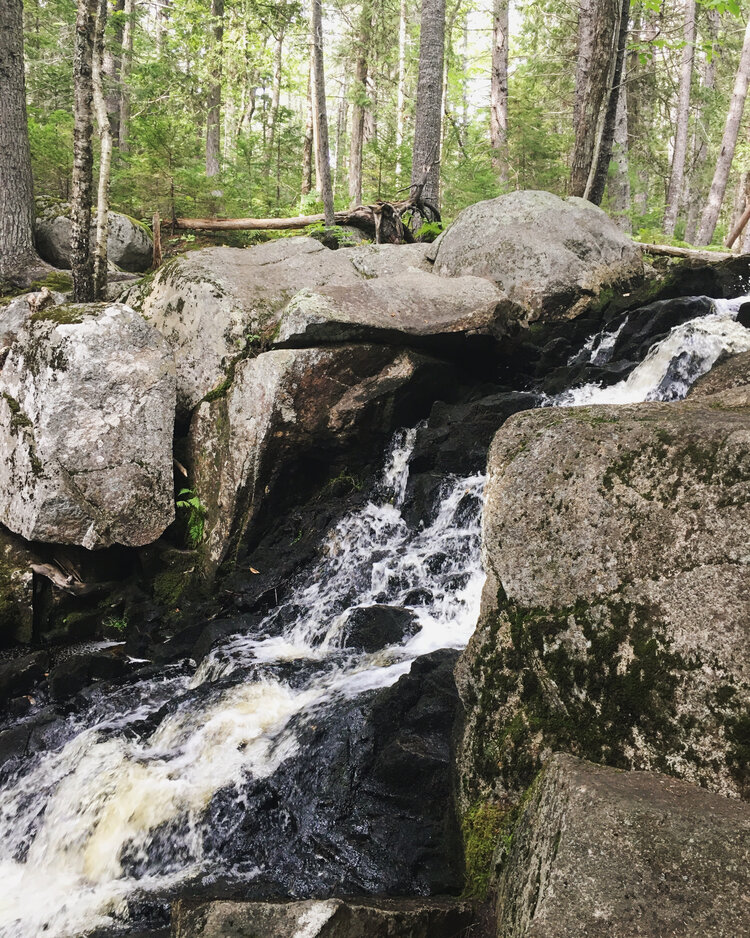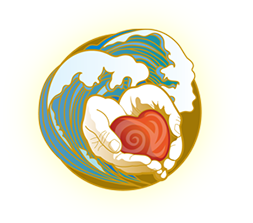Please visit Johanna Franzel’s website for more wonderful blogs: https://www.mycraniosacrallife.com/blog
Read on for a writing prompt to explore this theme in your own body.
There is a slippery and persistent question that lives under much of the work I do: What does healing even look like? Is it real? Do we know it when we see it?
Even that word – heal – is a complex and evasive little bugger. We know we aren’t working in the binary of broken and fixed, so does “getting better” mean… anything?
And then I meet a dog who has some answers.
It is at the last stop on our last day of camping that we meet her. With our dog bounding ahead, we take a trail that follows a small stream up through the woods to a waterfall that cascades into a deeper pool, the water dark with tannin from fallen pines. Coming down the trail are two men and a dog – a stout, grey Australian mix of something, with black spots on her back and a few across her nose. We stop to say hello as the dogs scamper and play and then it’s time to go.
Smokey! They call, Smokey, come here girl!
But what Smokey does is not come here at all. First, she trip traps up the rocks and moss, crosses the brook, crosses again, and finds a place where someone has dropped crumbs. Then she gets distracted, tumbles and tussles with our dog Rosie, crosses again, sniffs some ferns and remembers those crumbs.
Smokey! They call again. And she does look at them this time, but walks down the hill, past her humans and straight into the cool black water. She plops down on her haunches in the middle of the pool with a look of deep satisfaction, and extends her neck to admire the trees above.
I wish I had a photo of her at this moment to show you: cooling, entirely pleased. Imagine delight sitting in water, delight as a thick, grey black dog, and there she is.

They were patient, her two human companions, gently saying her name until, eventually, she did amble over.
How long had they had her? We asked.
5-weeks, they said. And explained that Smokey had spent her first year and half of life chained outdoors in Oklahoma. Those first weeks they’d brought her home she had cowered and hidden, whimpering at the sight of broomsticks. But lately that frozen tentativeness had started to soften. She was playing now, ease creeping back in. We could see it, how something had loosed in her body and, in her new safety, she had bigger things to do than follow orders. Or perhaps, what she was finally following was herself.
Healing – as we know too well – isn’t a linear or even obvious enterprise; we can find evidence of health in a million different subtle signs. But sometimes, returning to our bodies can look like this: more freedom, sovereignty, less obedience to outside rules. Fewer f*cks to give, we might say.
So much in the world right now is on fire – the toxicity of systems that incarcerate, control, demolish, diminish – we could get lost in the sorrow. Sometimes, we do.
But then a disobedient dog shows us how to live our lives connected to our inner compass rather than those external obligations. Shows what can be repaired in the face of real safety and abiding love. Sits with her beaming body in a pool of cool water regardless of what the world asks her to do. She has oriented to her own pleasure and, in her defiance, returns to herself.
Exploring this theme in your writing and body:
Take a moment to sit comfortably, locating breath, bones and the space around you. Then, bringing to mind an image of this satisfied dog, or your own picture of a person, animal, or place wholly inhabited of itself, begin to explore how the body might move if it followed its own compass. This need not look any particular way, we’re just experimenting with how permission might feel in a bodied way. Inviting softness, willing to be surprised by what shows up. Then, find your notebook and spend 10 minutes writing into this prompt: Following the inner compass.
Note: If you notice activation, please be slow and tender with yourself, allowing that awareness to be included also.

